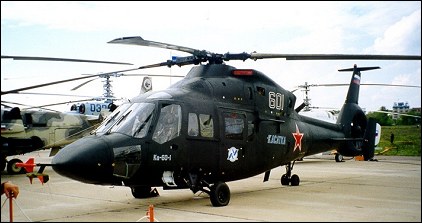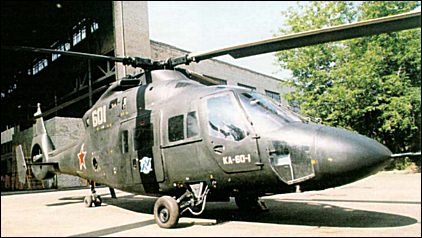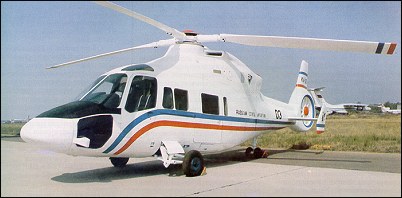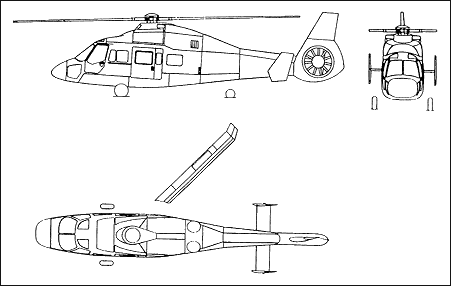Post by Stingray on Jul 11, 2008 19:25:54 GMT -4
Kamov V-60
Project
--------------------------------------------------------------------------------
en.wikipedia.org/wiki/Kamov_V-60
The V-60 was a projected light (3500kg) armed escort helicopter from Kamov based on the civil Ka-126. The project was abandoned in the 1980s and is often confused to be an early concept of the Ka-60. The initial prototype and preseries version of the Ka-60 carried a newer designation, V-62. Only a model of the original V-60 exists.
--------------------------------------------------------------------------------
Kamov Ka-60 "Kasatka"
1998

English name: Killer Whale
TYPE: Medium transport helicopter.
PROGRAMME: Original coaxial rotor, twin tail, single-engined V-60 won Soviet Army lightweight helicopter and Mi-8 replacement competition against heavier, twin-engined Mil Mi-36 in 1982; subsequently, design considerably modified to achieve greater speed through adoption of single main rotor and Fenestron-type of tail rotor with eleven blades. First flight originally due 1993, but programme slowed by funding shortages, and priority changed to promotion of civil variant (see Ka-62). Ka-60 officially revealed at Lyubertsy on 29 July 1997, when prototype close to completion; first flew (601) 10 December 1998; second sortie 21 December; first official flight 24 December; all were hovering flights; international debut at MAKS '99, Moscow, August 1999; first 'forward flight' 24 December 1999. Further testing was intermittent, due to irregular Ministry of Defence funding; production versions of RD-600V turboshaft installed mid-2002. At this time, it was stated only that the prototype had completed "several" flights, although State Trials were not due to begin until early 2003.
Conflicting reports quote both Arsenyev and Ulan Ude as prospective production lines. However, LMZ (now LAPIK, part of RSK "MiG") was reported in April 2000 to be preparing for production and in mid-2001 was building second prototype, which to be completed as a trainer in Ka-60U configuration. This entered final assembly in July 2002, although RD-600 engines were not due to have been received until late 2002. Displayed (marked as 602) at MAKS ‘03, Moscow, August 2003. Series production LAPIK was due to begin in 2003.
In August 2002, it was announced that power plant will be changed to Klimov VK-1500 to increase participation by RSK "MiG" group.
A smaller variant of Ka-60 was reported in mid-2001 to have been offered to Russian Navy.
CURRENT VERSIONS: Pilot and aircrew training (Ka-60U), utility, shipborne over-the-horizon targeting (Ka-60K) reconnaissance (Ka-60R) anti-tank and anli-helicopter versions proposed; role of Ka-60R, with Samsh*t target acquisition system, transferred to Kamov Ka-52.
CUSTOMERS: None. Long-term interest maintained by Russian Army; reportedly evaluated by Iran. Russian requirements estimated as over 100 Ka-60Us between 2001 and 2010.
COSTS: US$1.7 million, Ka-60U (2000).
DESIGN FEATURES: Generally as for Ka-62, but with IR- and radar-absorbent coatings, reduced rotor speed, low-IR exhausts.
POWER PLANT: Prototype has RKBM Rybinsk RD-600V Turboshafts, as Ka-62. Production engine will be 1,103kW Klimov VK-1500. RRTM RTM322 or GE CT7 available in export versions.
ACCOMMODATION: Up to 16 infantry troops; or six stretchers and three attendants. Pilot (starboard) and co-pilot/gunner (port) side by side. Provision for dual controls; control stick top common with Ka-50/52.
SYSTEMS: All Russian; Western equivalents optional for export.
AVIONICS: As above, including Pastel RWR and Otklik laser warning system.
Radar: Arbalet MMW antenna in nose.
Instrumentation: Three-screen EFIS.
EQUIPMENT: Cargo hook.
ARMAMENT: One-piece transverse boom through cabin, to rear of doors, optional to provide suspension for total of two B-8V-7 seven-round 80mm rocket pods, two 7.62mm or 12.7mm gun pods, or similar armament.
--Jane's All the World's Aircraft, 2004-2005

Ka-60 "Kasatka" is intended for carrying landing troops, delivery of weapons and ammunition to the battlefield area, evacuation of casualties, protection and patrol of economic zones when based on the ships, search and rescue operations, training of the crews.
Ka-60 helicopter has single-rotor scheme with five-blade rotor of 13.5-m diameter. The polymeric composite blade is attached to the hub by a torsion bar. The airframe features perfect aerodynamic outlines, large door openings on both fuselage sides, retractable three-leg energy-absorbing landing gear and multi-blade (11 blades) tail rotor in the tail ring. The seats of the crew and the troopers are energy attenuating seats. The pilot-in-command is on the right-hand seat. The power plant of the helicopter is comprised of new-generation modular-design engines developed by Rybinsk Motor Design Bureau, headed by Mr. A. Novikov, Designer General.
Particular attention is paid to the increased combat survivability means of the helicopter. All principal systems and units of Ka-60 are duplicated and separated. The rotor blades with several holes from the automatic gun hits remain operable. The control system links and transmission shafts sustain the hits of 12.7-mm bullets. The composite polymeric materials that make about 60% of the helicopter structural weight also add to the increased survivability of the helicopter being more resistant to the combat damages. The foam polyurethane that filled the tanks prevents the danger of the fuel explosion. Higher survivability of the helicopter in the battlefield is also achieved by lower optical, IR and radar signatures.
The on-board avionics suite depends on the application version of the helicopter. The basic suite for all versions is the one for transport assault helicopter. This suite ensures operational missions in daytime and night, in VFR and IFR conditions.
-- www.airshow.ru
Technical data for Ka-60
Crew: 1-2, engine: 2 x Rybinsk RD-600 turboshaft, rated at 975kW, main rotor diameter: 13.5m, take-off weight: 6500kg, max speed: 300km/h, cruising speed: 265km/h, hovering ceiling: 2100m, service ceiling: 5150m, range: 700km, payload: 2000-2750kg
--------------------------------------------------------------------------------
Kamov Ka-62
1996

Medium multi-purpose helicopter with 14-passenger cabin, retractable tailwheel u/c, fenestron tail powered by two RKMB RD-600, Glushenkov TVD-155 or Turbomeca RTM322 turboshafts.
--R.Simpson "Airlife's Helicopter and Rotorcraft", 1998

Ka-62 is developed on the basis of Ka-60 army helicopter and is intended for carrying passengers and cargo in the transport cabin, and transportation of bulky cargo on external sling.
Ka-62 helicopter has single-rotor scheme with multi-blade tail rotor in the tail ring. The rotor blades and 60% of the airframe weight are made of polymeric composite materials. The airframe features perfect aerodynamic outlines, large transport-passenger cabin and retractable three-leg landing gear. The power plant of the helicopter is made of new-generation modular-design engines developed by Rybinsk Motor Design Bureau, headed by Mr. A. Novikov, Designer General. The civil derivative of the helicopter inherited from the basic army version its high cruise speed, fuel efficiency and transport capacity as well as large door openings of the transport cabin on both fuselage sides.
The helicopter can be used for comfortable passenger transportation, for internal and external cargo transportation, it can perform first aid medical operations, search-and-rescue operation, water boarders and economic zone boarders patrol, for servicing coastal gas and oil lines.
The Ka-62 helicopter is designed with account to the international flight safety requirements. OEI flight and landing are ensured. The safety of the pilot and passengers during rough landing is guaranteed by a set of measures, including the energy-absorbing and energy-attenuating design of the landing gear and seats. The tail rotor in the tail ring is protected against casual damages. The helicopter is equipped with efficient anti-icing and fire-fighting systems.The
Ka-62 is equipped with standard avionics suite of a basic transport version for VFR conditions, or a suite for IFR flying in any weather conditions, using the satellite navigational equipment. The export version of the helicopter is supplied with the engines and avionics of western companies at customer's option.
-- www.airshow.ru
TYPE: Multirole medium helicopter.
PROGRAMME: Funded under Russian programme for development of civil aviation for 2000. Construction of prototype Ka-62 (then known as V-62) began early 1990, but apparently abandoned; one Ka-60 military version and two Ka-62s intended to undertake flight trials, although second of basic type completed as Ka-60U, delaying debut of civil version; will be certified under Russian AP and FAR Pt 29A/B standards. Republic of Buryatia officially requested Moscow for production rights for UUAP in February 2000. In April 2001, Turkish Ministry of Public Health was discussing contract for six Ka-62s, with total value of US$31.5 million. Russian government's 2002-10 aviation plan includes Rb62 million to develop Ka-62 and Rb51 million to launch production at UUAP and, possibly, RSK "MiG" (LAPIK). Initial deployment will be in Khabarovsk Federal District of Russian Far East, following June 2002 agreement between Kamov and Far East Investment Company for manufacture of Ka-62 at unspecified plant(s) and marketing in Asia/Pacific region.
CURRENT VERSIONS:
Ka-62: Basic model for domestic market.
Detailed description applies to the above.
Ka-62M: To be certified to Western standards, for sale outside Russian Federation and Associated States (CIS); two 1,212kW General Electric T700/CT7-2D1 turboshafts; five-blade main rotor: avionics to be developed by Aviapribor. Production version is expected to be manufactured by KnAAPO at Komsomolsk.
Ka-64 Sky Horse: This development of the Ka-60/62 series is reported to be a joint venture with Agusta of Italy intended for export. Features include a conventional tail rotor, modified passenger cabin. Western avionics and option of General Electric CT7-2DL, LHTEC T800 or RTM 322 turboshaft engines. Production would be by UUAP at Ulan-Ude.
DESIGN FEATURES: Originated as military transport; all main systems and components duplicated, with main and secondaries routed on opposite sides of airframe; transmission resistant to 12.7mm bullets; main blades to 23mm shells; run-dry gearboxes. Advanced technology main rotors with sweptback tips. Production versions will have slower-turning five-blade rotor. Yaw control by 11-blade fan-in-fin. Reverse tricycle landing gear.
STRUCTURE: Composites account for 60%, by weight, of structure, including blades of main rotor; fuselage sides, doors, floor and roof, tailboom, fin, vertical stabilisers, and fan blades of carbon-reinforced Kevlar.
LANDING GEAR: Retractable reverse tricycle type; single KT-217 mainwheels retract inward and upward into bottom of fuselage; twin rear wheels retract forward into tailboom; shock-absorber in each unit. Optional inflatable pontoons for emergency use on water.
POWER PLANT: Basic Ka-62 has two RKBM Rybinsk RD-600V turboshafts, each 956kW max continuous; 1,140kW emergency rating. However 1,103kW Klimov VK-1500 may be offered in parallel with adoption of this engine for Ka-60. Fuel tanks under floor, capacity 1,450 litres. General Electric T700/ CT7-2D1 offered as alternative to RD-600V.
ACCOMMODATION: Crew of one or two, side by side; optional bulkhead divider between flight deck and cabin; up to 14 passengers in four rows; forward-hinged door each side of flight deck; large forward-sliding door and small rearward-hinged door each side of cabin; baggage hold to rear of cabin. VIP configuration to be available, with five to nine seats and refreshment bar.
SYSTEMS: Interior heated and air conditioned. Thermoelectric de-icing system optional. Ivchenko AI-9V APU originally proposed, but replacement Aerosila TA-14 under development.
AVIONICS: Optional Russian or Western.
EQUIPMENT: Stretchers, hoist above port cabin door, cargo tiedowns, and other items as necessary for variety of roles, including transport of slung freight; air ambulance/ operating theatre; search and rescue; patrol of highways, forests, electric power lines, gas and oil pipelines; survey of ice areas; surveillance of territorial waters, economic areas and fisheries; mineral prospecting; and servicing of offshore gas and oil rigs.
--Jane's All the World's Aircraft, 2004-2005
Technical data for Ka-62
Crew: 1-2, passengers: 16, engine: 2 x Rybinsk RD-600 turboshaft, rated at 955kW, main rotor diameter: 13.5m, fuselage length: 13.25m, height: 4.1m, take-off weight: 6250kg, empty weight: 3730kg, max speed: 300km/h, cruising speed: 260km/h, rate of climb: 11.7m/s, hovering ceiling: 2500m, service ceiling: 5000m, range: 720km, payload: 2000-2500kg
Project
--------------------------------------------------------------------------------
en.wikipedia.org/wiki/Kamov_V-60
The V-60 was a projected light (3500kg) armed escort helicopter from Kamov based on the civil Ka-126. The project was abandoned in the 1980s and is often confused to be an early concept of the Ka-60. The initial prototype and preseries version of the Ka-60 carried a newer designation, V-62. Only a model of the original V-60 exists.
--------------------------------------------------------------------------------
Kamov Ka-60 "Kasatka"
1998

English name: Killer Whale
TYPE: Medium transport helicopter.
PROGRAMME: Original coaxial rotor, twin tail, single-engined V-60 won Soviet Army lightweight helicopter and Mi-8 replacement competition against heavier, twin-engined Mil Mi-36 in 1982; subsequently, design considerably modified to achieve greater speed through adoption of single main rotor and Fenestron-type of tail rotor with eleven blades. First flight originally due 1993, but programme slowed by funding shortages, and priority changed to promotion of civil variant (see Ka-62). Ka-60 officially revealed at Lyubertsy on 29 July 1997, when prototype close to completion; first flew (601) 10 December 1998; second sortie 21 December; first official flight 24 December; all were hovering flights; international debut at MAKS '99, Moscow, August 1999; first 'forward flight' 24 December 1999. Further testing was intermittent, due to irregular Ministry of Defence funding; production versions of RD-600V turboshaft installed mid-2002. At this time, it was stated only that the prototype had completed "several" flights, although State Trials were not due to begin until early 2003.
Conflicting reports quote both Arsenyev and Ulan Ude as prospective production lines. However, LMZ (now LAPIK, part of RSK "MiG") was reported in April 2000 to be preparing for production and in mid-2001 was building second prototype, which to be completed as a trainer in Ka-60U configuration. This entered final assembly in July 2002, although RD-600 engines were not due to have been received until late 2002. Displayed (marked as 602) at MAKS ‘03, Moscow, August 2003. Series production LAPIK was due to begin in 2003.
In August 2002, it was announced that power plant will be changed to Klimov VK-1500 to increase participation by RSK "MiG" group.
A smaller variant of Ka-60 was reported in mid-2001 to have been offered to Russian Navy.
CURRENT VERSIONS: Pilot and aircrew training (Ka-60U), utility, shipborne over-the-horizon targeting (Ka-60K) reconnaissance (Ka-60R) anti-tank and anli-helicopter versions proposed; role of Ka-60R, with Samsh*t target acquisition system, transferred to Kamov Ka-52.
CUSTOMERS: None. Long-term interest maintained by Russian Army; reportedly evaluated by Iran. Russian requirements estimated as over 100 Ka-60Us between 2001 and 2010.
COSTS: US$1.7 million, Ka-60U (2000).
DESIGN FEATURES: Generally as for Ka-62, but with IR- and radar-absorbent coatings, reduced rotor speed, low-IR exhausts.
POWER PLANT: Prototype has RKBM Rybinsk RD-600V Turboshafts, as Ka-62. Production engine will be 1,103kW Klimov VK-1500. RRTM RTM322 or GE CT7 available in export versions.
ACCOMMODATION: Up to 16 infantry troops; or six stretchers and three attendants. Pilot (starboard) and co-pilot/gunner (port) side by side. Provision for dual controls; control stick top common with Ka-50/52.
SYSTEMS: All Russian; Western equivalents optional for export.
AVIONICS: As above, including Pastel RWR and Otklik laser warning system.
Radar: Arbalet MMW antenna in nose.
Instrumentation: Three-screen EFIS.
EQUIPMENT: Cargo hook.
ARMAMENT: One-piece transverse boom through cabin, to rear of doors, optional to provide suspension for total of two B-8V-7 seven-round 80mm rocket pods, two 7.62mm or 12.7mm gun pods, or similar armament.
--Jane's All the World's Aircraft, 2004-2005

Ka-60 "Kasatka" is intended for carrying landing troops, delivery of weapons and ammunition to the battlefield area, evacuation of casualties, protection and patrol of economic zones when based on the ships, search and rescue operations, training of the crews.
Ka-60 helicopter has single-rotor scheme with five-blade rotor of 13.5-m diameter. The polymeric composite blade is attached to the hub by a torsion bar. The airframe features perfect aerodynamic outlines, large door openings on both fuselage sides, retractable three-leg energy-absorbing landing gear and multi-blade (11 blades) tail rotor in the tail ring. The seats of the crew and the troopers are energy attenuating seats. The pilot-in-command is on the right-hand seat. The power plant of the helicopter is comprised of new-generation modular-design engines developed by Rybinsk Motor Design Bureau, headed by Mr. A. Novikov, Designer General.
Particular attention is paid to the increased combat survivability means of the helicopter. All principal systems and units of Ka-60 are duplicated and separated. The rotor blades with several holes from the automatic gun hits remain operable. The control system links and transmission shafts sustain the hits of 12.7-mm bullets. The composite polymeric materials that make about 60% of the helicopter structural weight also add to the increased survivability of the helicopter being more resistant to the combat damages. The foam polyurethane that filled the tanks prevents the danger of the fuel explosion. Higher survivability of the helicopter in the battlefield is also achieved by lower optical, IR and radar signatures.
The on-board avionics suite depends on the application version of the helicopter. The basic suite for all versions is the one for transport assault helicopter. This suite ensures operational missions in daytime and night, in VFR and IFR conditions.
-- www.airshow.ru
Technical data for Ka-60
Crew: 1-2, engine: 2 x Rybinsk RD-600 turboshaft, rated at 975kW, main rotor diameter: 13.5m, take-off weight: 6500kg, max speed: 300km/h, cruising speed: 265km/h, hovering ceiling: 2100m, service ceiling: 5150m, range: 700km, payload: 2000-2750kg
--------------------------------------------------------------------------------
Kamov Ka-62
1996

Medium multi-purpose helicopter with 14-passenger cabin, retractable tailwheel u/c, fenestron tail powered by two RKMB RD-600, Glushenkov TVD-155 or Turbomeca RTM322 turboshafts.
--R.Simpson "Airlife's Helicopter and Rotorcraft", 1998

Ka-62 is developed on the basis of Ka-60 army helicopter and is intended for carrying passengers and cargo in the transport cabin, and transportation of bulky cargo on external sling.
Ka-62 helicopter has single-rotor scheme with multi-blade tail rotor in the tail ring. The rotor blades and 60% of the airframe weight are made of polymeric composite materials. The airframe features perfect aerodynamic outlines, large transport-passenger cabin and retractable three-leg landing gear. The power plant of the helicopter is made of new-generation modular-design engines developed by Rybinsk Motor Design Bureau, headed by Mr. A. Novikov, Designer General. The civil derivative of the helicopter inherited from the basic army version its high cruise speed, fuel efficiency and transport capacity as well as large door openings of the transport cabin on both fuselage sides.
The helicopter can be used for comfortable passenger transportation, for internal and external cargo transportation, it can perform first aid medical operations, search-and-rescue operation, water boarders and economic zone boarders patrol, for servicing coastal gas and oil lines.
The Ka-62 helicopter is designed with account to the international flight safety requirements. OEI flight and landing are ensured. The safety of the pilot and passengers during rough landing is guaranteed by a set of measures, including the energy-absorbing and energy-attenuating design of the landing gear and seats. The tail rotor in the tail ring is protected against casual damages. The helicopter is equipped with efficient anti-icing and fire-fighting systems.The
Ka-62 is equipped with standard avionics suite of a basic transport version for VFR conditions, or a suite for IFR flying in any weather conditions, using the satellite navigational equipment. The export version of the helicopter is supplied with the engines and avionics of western companies at customer's option.
-- www.airshow.ru
TYPE: Multirole medium helicopter.
PROGRAMME: Funded under Russian programme for development of civil aviation for 2000. Construction of prototype Ka-62 (then known as V-62) began early 1990, but apparently abandoned; one Ka-60 military version and two Ka-62s intended to undertake flight trials, although second of basic type completed as Ka-60U, delaying debut of civil version; will be certified under Russian AP and FAR Pt 29A/B standards. Republic of Buryatia officially requested Moscow for production rights for UUAP in February 2000. In April 2001, Turkish Ministry of Public Health was discussing contract for six Ka-62s, with total value of US$31.5 million. Russian government's 2002-10 aviation plan includes Rb62 million to develop Ka-62 and Rb51 million to launch production at UUAP and, possibly, RSK "MiG" (LAPIK). Initial deployment will be in Khabarovsk Federal District of Russian Far East, following June 2002 agreement between Kamov and Far East Investment Company for manufacture of Ka-62 at unspecified plant(s) and marketing in Asia/Pacific region.
CURRENT VERSIONS:
Ka-62: Basic model for domestic market.
Detailed description applies to the above.
Ka-62M: To be certified to Western standards, for sale outside Russian Federation and Associated States (CIS); two 1,212kW General Electric T700/CT7-2D1 turboshafts; five-blade main rotor: avionics to be developed by Aviapribor. Production version is expected to be manufactured by KnAAPO at Komsomolsk.
Ka-64 Sky Horse: This development of the Ka-60/62 series is reported to be a joint venture with Agusta of Italy intended for export. Features include a conventional tail rotor, modified passenger cabin. Western avionics and option of General Electric CT7-2DL, LHTEC T800 or RTM 322 turboshaft engines. Production would be by UUAP at Ulan-Ude.
DESIGN FEATURES: Originated as military transport; all main systems and components duplicated, with main and secondaries routed on opposite sides of airframe; transmission resistant to 12.7mm bullets; main blades to 23mm shells; run-dry gearboxes. Advanced technology main rotors with sweptback tips. Production versions will have slower-turning five-blade rotor. Yaw control by 11-blade fan-in-fin. Reverse tricycle landing gear.
STRUCTURE: Composites account for 60%, by weight, of structure, including blades of main rotor; fuselage sides, doors, floor and roof, tailboom, fin, vertical stabilisers, and fan blades of carbon-reinforced Kevlar.
LANDING GEAR: Retractable reverse tricycle type; single KT-217 mainwheels retract inward and upward into bottom of fuselage; twin rear wheels retract forward into tailboom; shock-absorber in each unit. Optional inflatable pontoons for emergency use on water.
POWER PLANT: Basic Ka-62 has two RKBM Rybinsk RD-600V turboshafts, each 956kW max continuous; 1,140kW emergency rating. However 1,103kW Klimov VK-1500 may be offered in parallel with adoption of this engine for Ka-60. Fuel tanks under floor, capacity 1,450 litres. General Electric T700/ CT7-2D1 offered as alternative to RD-600V.
ACCOMMODATION: Crew of one or two, side by side; optional bulkhead divider between flight deck and cabin; up to 14 passengers in four rows; forward-hinged door each side of flight deck; large forward-sliding door and small rearward-hinged door each side of cabin; baggage hold to rear of cabin. VIP configuration to be available, with five to nine seats and refreshment bar.
SYSTEMS: Interior heated and air conditioned. Thermoelectric de-icing system optional. Ivchenko AI-9V APU originally proposed, but replacement Aerosila TA-14 under development.
AVIONICS: Optional Russian or Western.
EQUIPMENT: Stretchers, hoist above port cabin door, cargo tiedowns, and other items as necessary for variety of roles, including transport of slung freight; air ambulance/ operating theatre; search and rescue; patrol of highways, forests, electric power lines, gas and oil pipelines; survey of ice areas; surveillance of territorial waters, economic areas and fisheries; mineral prospecting; and servicing of offshore gas and oil rigs.
--Jane's All the World's Aircraft, 2004-2005
Technical data for Ka-62
Crew: 1-2, passengers: 16, engine: 2 x Rybinsk RD-600 turboshaft, rated at 955kW, main rotor diameter: 13.5m, fuselage length: 13.25m, height: 4.1m, take-off weight: 6250kg, empty weight: 3730kg, max speed: 300km/h, cruising speed: 260km/h, rate of climb: 11.7m/s, hovering ceiling: 2500m, service ceiling: 5000m, range: 720km, payload: 2000-2500kg





